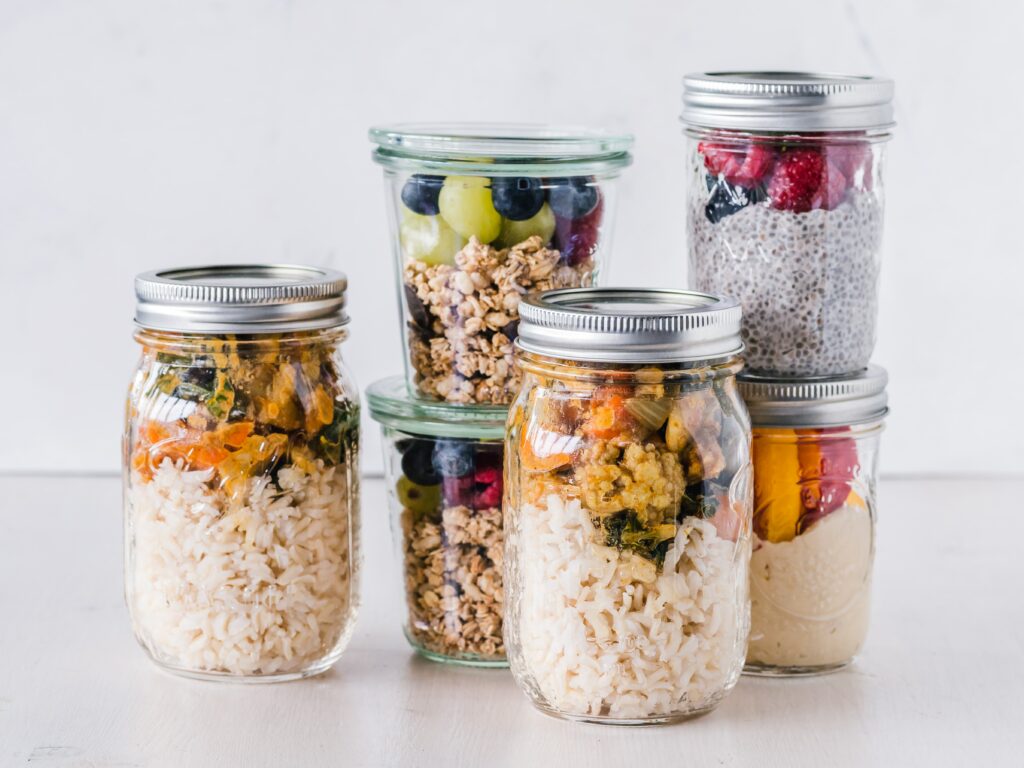With little ones back in school, it’s time to pack nourishing, kid-friendly lunch boxes. But what should toddlers eat? And how can you get creative when your child’s particularness is discouraging? Knowing what to pack is stressful. I get it. If you’re stumped over what to piecemeal for snacks and lunches, look no further. These 15 toddler lunch box ideas—for preschool—will help keep their energy up and their blood sugar stable. Without further ado, I’m sharing a simple lunch box formula, as well as tips and tricks for raising healthy eaters. This guide will spark inspiration and help make lunch box prep easy, healthy, and fun.

children are intuitive eaters
One of the most powerful things we can glean from our children is how in tune they are with their hunger cues. They’re intuitive eaters. And while their pickiness can certainly be frustrating, it’s our responsibility to model healthy behaviors around food—including staying calm when they refuse to eat what’s for dinner. Ultimately, when given the space to eat unconditionally, they can develop a healthy relationship with food. And this can have a positive, lifelong impact. As many of us know, a negative relationship with food can lead to an everlasting struggle with body image, self-confidence, and weight. But by encouraging your kids to foster a natural, trustful relationship with food, maybe you’ll find healing for yourself—too.

How to raise a normal eater
While normal looks different for everyone, the gist is to raise children to have a mindful yet enjoyable (read: stress-free!) relationship with food.
1. STRIVE for body neutrality
Rather than strive for body positivity around your kids, strive for body neutrality. Remember, how you regard your body will influence your child’s perceptions about “good” bodies—and how their own bodies compare to this standard. Rather than focus on your child’s size (which will change over time), note how we all come in different shapes and sizes.
2. use non-food rewards
Easier said than done. But the problem with this is that it automatically deems certain foods are good and others are bad (not the goal). However, non-food rewards, like special activities or a day out with a parent, can be just as effective.
3. LET GO OF THE CLEAN PLATE CLUB
Remember that children are intuitive eaters. They know when they are hungry and when they are full. They might gravitate toward some foods more than others, and in that case, you can explore more foods together.
4. PRIORITIZE FAMILY MEALS
Family meals are crucial for how to raise a normal eater. After all, they protect against disordered eating. Planning family meals with busy schedules can feel impossible—therefore, aim to eat together as often as possible, even if it’s not every night.
Expanded tips on how to raise a normal eater, plus book suggestions, here.

5 Nutrients toddlers need to grow
Before we dive into toddler lunch box ideas for preschool, it’s helpful to understand what nutrients help toddlers grow, have energy, etc. As a whole, it’s pretty easy to provide the nutrients your child needs—particularly once you learn what they are.
Iron
Iron helps move oxygen from the lungs to the rest of the body. It’s essential! It’s best to turn to real food sources to help meet your toddler’s need for iron. For example, meat, seafood, poultry, lentils, beans, tomato puree, and quinoa. To increase absorption, pair iron with vitamin C (citrus, bell peppers, etc.).
Protein
Protein is another essential nutrient for your child’s growth and maintenance. Of all the nutrients kids need to be healthy, protein is key. Protein also contains many additional nutrients: iron, omega 3s, zinc, B vitamins, vitamin D, calcium, and selenium. If your child is plant-based, chat with your pediatrician about a B12 supplement.
Omega-3s
Healthy fats are vital for everyone. They protect major organs, increase nutrient absorption, prevent constipation, and stabilize blood sugar. And of course, they keep toddlers full and satisfied. The human brain is made up of nearly 60% fat, specifically DHA. DHA is found in fatty fish (ex: sardines or salmon), grass-fed beef, and algae. If your little one is vegan or mostly plant-based, my recommended plant-based source of DHA supplementation is marine algae.
Calcium
Calcium is vital for building strong bones and teeth. For optimal absorption, pair foods with calcium with fat. Kid-friendly foods with calcium include plain yogurt, canned sardines (mashed with avocado), kefir (add to a smoothie), salmon, chia seeds, tahini, and spinach.
Choline
Choline is not a widely recognized nutrient, but it plays a crucial role in your child’s development. It supports brain development, enhances memory, improves cognitive function, and more. Food sources of choline include eggs, liver, salmon, beef, beans, lentils, and yogurt.

Follow this easy lunch box formula
There’s something momentous about opening your child’s lunch box, only to be pleasantly surprised by its emptiness (or near emptiness). It makes you feel superhuman—like you’ve solved the world’s problems, one lunch at a time. Or, maybe that’s just me? At any rate, here’s the lunch box formula I use to pack nutritious meals for toddlers. Follow this guide, and you’ll promote blood sugar balance, encourage satiation, and bring fun to functional foods.
Main + Fruit + Veggie + Snack / Treat
Main: protein, sandwich, wrap, quesadilla, pasta salad, pita + hummus, meatballs, pizza, egg bites, etc.
Fruit: berries, clementines, apples, grapes, banana, pear, stone fruit, watermelon, etc.
Veggie: carrot sticks, cherry tomatoes, cucumber, roasted veggies, zucchini, kale chips, potatoes, olives, etc.
Snack / Treat: crackers, veggie sticks, chocolate, nourishing snack bars, etc.

15 toddler lunch box ideas for preschool
In need of healthy lunch box ideas? Look no further. Keep in mind that you can also involve your toddler in the lunch-packing operation! To begin, create a go-to snack drawer. Consider this is the “school lunch basket.” If possible, buy these items in bulk—you’ll save money while having a drawer full of healthy snacks. This gives your child choices and a bit of authority.
Lunch box ideas:
Turkey sandwich with pesto and provolone on sourdough + apple slices + cucumber sticks with hummus + honey cinnamon crackers.
Egg bites + ketchup + cantaloupe + nut-free granola bar.
Shredded rotisserie chicken + sprouted wheat pita + string cheese + clementine.
Leftover pizza + roasted zucchini + blueberries + cocoa cashew creme cookies.
Sunflower seed butter sandwich on sprouted grain bread with mashed raspberries and chia seeds + yogurt + allergy-friendly granola bar.
Fried rice + edamame + clementine + coconut chips.
Meatballs + steamed broccoli + hummus + breakfast snack bar.
Cheese quesadilla + guacamole + mashed black beans with sea salt + berries.
Baked tofu + BBQ sauce + sauerkraut + watermelon.
Ground meat (turkey, ground beef, or tofu) with mild taco seasoning + roasted sweet potato fries + avocado + sliced kiwi.
Pasta (ideally with chickpea or lentil-based pasta) with olive oil, sprinkled with parm and hemp seeds + blueberries + allergy-friendly granola bar.
Chicken nuggets + roasted summer squash + ketchup + strawberries.
Hummus-a-dilla (quesadilla with hummus) + black olives + carrot sticks + ranch dressing + cheddar crackers.
Cottage cheese topped with hemp seeds and berries + veggie sticks + cocoa cashew creme cookies.
Mac and cheese + green pea crisps + strawberries + hard-boiled egg.

Best Toddler lunch box containers
Cup of coffee in hand, happy packing! Speaking of, if you’re on the hunt for your child’s lunch box, check out these: leak-proof bento-style box, insulated lunch box for elementary kids, compartment-style box with a removable ice pack, or this cute and colorful lunch box for toddlers. As far as containers are concerned, we love these stainless steel containers and this bento-style snack box. This leak-proof water bottle is great too.
This article contains affiliate links. Thank you for supporting Wellness with Edie! This article is for informational purposes only. It is not, nor is it intended to be, a substitute for professional medical advice, diagnosis, or treatment and we recommend that you always consult with your healthcare provider.



Leave a Reply